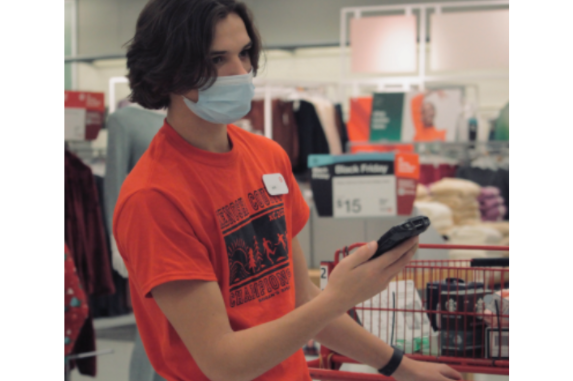
Photo by Curtis Lindgren, Photo Director
Article by Katlyn Marotz, Co-Editor-in-Chief

For teenagers at Indian Trail High School, getting a job remains a stressful decision that comes
with many repercussions, especially when they consider how COVID-19 affects their workplace,
customer behavior, and their personal safety.
IT senior Jane Sekas, 17, has worked at Olive Garden restaurant as a hostess for about four
months.
One of the main problems she has dealt with is management acting “wishy washy” with breaks.
Sometimes managers schedule people just under six hours so workers won’t get a break, or an
employee gets a break but it won’t be the right amount of time.
“I think that’s something that we all notice and we won’t say anything because we think we
might get fired,” Sekas said.
One of the reasons her co-workers don’t fight back is because they don’t want retaliation or to
cause problems within the workplace.
Sekas also said the worker shortage heavily impacts everyone and disrupts the workplace flow.
It creates a domino effect of stress, where each server, busser, hostess, cook, or any employee is
affected.
“A big problem is that the older patrons don’t understand that we aren’t in control of anything that might be inconveniencing them,” Sekas said. “They might see empty tables, but we can’t seat them there because there’s no server there. We’re sorry that the food is slow getting out, but there are 20 or 30 other groups of people who also want food.”
“There’s just this general entitlement and expectation that nobody can meet because we’re working with a very bare minimum,” she added.
According to a 2019 study by the Brookings Institution, in 1979 about 60% of teens had a job, whereas in 2019, only 35% of teens between 16 and 19 have a job.
Sekas said if working isn’t a necessity for teenagers, most won’t put up with bad working conditions or inadequate wages, especially if there are other outside personal factors.
“Teenagers are expected to do well in school and do extracurriculars for college, and then you have to go and work for the remaining hours you have free. A lot of people don’t want to do that, including me,” she said.
Parents and other adults expect teens to get a job.
“It’s an expectation that can’t necessarily be met, and that’s making teenagers just not want to do it at all,” she said.
******************
Still, some teens are finding success in the workplace.
Nick Fonk, an IT senior, originally got his Target fulfillment employee job through his sister who also works there. He said the $15 an hour wage was the main factor that hooked him into working at Target.
“All the co workers are very nice and will help me if I need it. Plus, the break room is always clean, and overall it’s just a great place to work,” Fonk said.
Fonk appreciates not feeling like a number in his job. For how big it is, Target makes everyone feel heard.
“I don’t really know how to explain it but I have never had thoughts of quitting because of the environment,” said the 17 year old. “Whenever anyone asks me how I like working there, I always bring up how it has a great working environment.”
Fonk has his own theory as to why fewer teens have jobs today than decades ago.
“They don’t like to work or are just lazy. Also, they want to live out their teen years having fun, not locked up in a job,” he said.
******************
Shannon Aide, a senior at IT, works as a certified nursing assistant at Froedtert Pleasant Prairie Hospital, through IT’s Youth Apprenticeship program.
Aide said she was glad she could observe and ask questions of experienced medical workers at only age 17 and accomplish so much while she is still in high school.
“We have staffing issues, and we’ve had some people quit because of the mandated vaccinations,” Aide said. “It’s a lot of stressed people doing their best. And I love my co-workers. We’re just all working together to try to provide the best care for the patients that we have.”
Just about every company has management issues now, Aide said.
“We have had a lot of over working and understaffing issues,” she said.
Other problems that the COVID-19 pandemic has caused are supply issues. Her work has had to substitute products, such as cleaning supplies, because there aren’t enough products. And this causes even more stress.
“A lot of times it takes a while to get patients to where they need to go. Like procedure wise or discharge wise,” she said. “People will have to sit waiting to get dis-
charged, and it’ll take a few hours. And it’s not anyone’s fault. We’re all doing the best we can, but we don’t have a lot of staff to do things as fast as people want.”
A reason teens might not want to work at a hospital is because they don’t want to get exposed to different types of illnesses, Aide said. And because working at a hospital requires a strong commitment.
But she said she believes that it is very beneficial to get a job, even if it takes multiple attempts to find the right one. It still will give a person valuable experience, she said.
YA attracts record number of job seekers, but local employers still short of workers
Lora Lehmann, a Youth Apprenticeship specialist at IT, said 110 students are participating in the YA program this year, their highest numbers yet.
There are over 70 pathways and 11 industries within them, in the Youth apprenticeship program. The biggest industry filled at IT is medical science, making up 30%, and communications and business are tied at 6.5%. Lehmann also noted that 56.5% of the program is made up of diverse students.
“This year it’s very unusual. I feel like there’s a bottle neck from COVID last year since we were in a hybrid and virtual model,” Lehmann said.
Still, there are more employers than student applicants.
“I have dozens of employers and opportunities for students that I am constantly trying to fill,” she said.
Marketing and sales, merchandising, hospitality, and manufacturing are the biggest fields that need more workers.
“There is a bit of a downturn just getting students back out, connecting with other people, because of being isolated for so long,” Lehmann said.
According to Pew Research Center’s 2021 analysis of federal employment, during the summer of the pandemic of 2020, teen employment reached an all-time low since the
Great Recession in America. About 31% of teens had a summer job.
Lehmann also said she believes it will be extremely challenging for local businesses to start or start back up again because of factors like wage increases or supply chain issues.
She said she feels students still have initiative to find work, and it is very critical to give students the opportunity to get ahead in their career.
